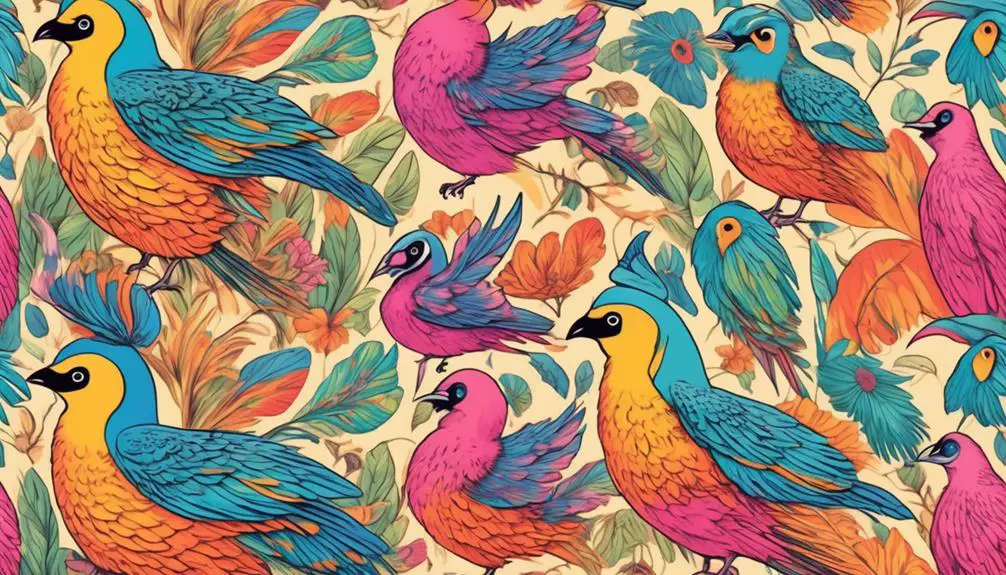Have you ever wondered which animals possess the remarkable adaptation of feathers? It is commonly believed that only birds have feathers, but is that really the case?
In this exploration, we will challenge this theory and uncover some surprising facts about the presence of feathers in the animal kingdom. Prepare to be amazed as we uncover the unexpected creatures that boast this fascinating feature.
Types of Feathers

When it comes to the fascinating world of feathers, it’s important to understand the various types that exist among different bird species.
Pigeons, for example, have a range of feathers including down feathers, hair feathers, fluff feathers, contour feathers, tail feathers, and wing feathers.
Owls, on the other hand, possess contour feathers, down feathers, semiplumes, bristles, and filoplumes.
Eagles have rectrices, scapulars, and tertials, while chickens have downy yellow feathers in hatchlings and regular feathers in mature chickens.
Penguins have small and stiff feathers, while emus have long brown feathers and shorter feathers on their necks.
Robins have distinctive and colorful feathers, while hummingbirds have ten primary feathers, six to seven secondary feathers, and ten tail feathers.
Peacocks are known for their beautiful tail feathers and wing feathers, while cardinals have primary feathers, rectrices, and secondary feathers.
Understanding the different types of feathers is crucial in comprehending the adaptations and characteristics of each bird species.
Appearance and Coloration

Now, let’s explore the fascinating world of appearance and coloration in birds with feathers.
From the iridescent green and turquoise feathers of pigeons to the specific colors and patterns of owls for camouflage, birds exhibit a wide range of colorful plumage variations.
Some feathers serve as a means of blending in with their surroundings, while others display vibrant hues to attract mates or establish dominance.
Join us as we delve into the intricate world of bird coloration and its role in their survival and communication.
Colorful Plumage Variations
Peacocks possess the most striking and vibrant plumage among birds, characterized by their distinctive patterns and a wide array of dazzling colors. The feathers of a peacock are renowned for their iridescent hues, ranging from deep blues and greens to shimmering golds and purples. These intricate colors are created by microscopic structures in the feathers that reflect and refract light, resulting in a dazzling display.
The unique patterns on peacock feathers, known as ‘eye’ markings, are formed by dark spots surrounded by concentric rings of contrasting colors. These eye-catching plumage variations serve multiple purposes, including attracting mates during courtship displays and deterring predators through visual intimidation.
The beauty and complexity of peacock plumage make them one of nature’s most remarkable examples of colorful feather adaptations.
Camouflage and Patterns
The coloration and patterns of feathers play a crucial role in the camouflage and appearance of various bird species. Camouflage allows birds to blend in with their surroundings, making it easier for them to evade predators or sneak up on prey.
For instance, owls have specific colors and patterns on their feathers that help them blend into tree bark or foliage. This helps them remain unseen while hunting. Some birds, such as the robin, have rust-colored feathers on their chests that provide excellent camouflage against the colors of the forest floor.
Additionally, certain patterns on feathers, such as the distinctive ‘eye’ markings on peacock tail feathers, serve as visual signals to attract mates or establish dominance.
The intricate coloration and patterns of feathers aren’t only beautiful but also serve essential functions in the survival and behavior of birds.
Function of Feathers
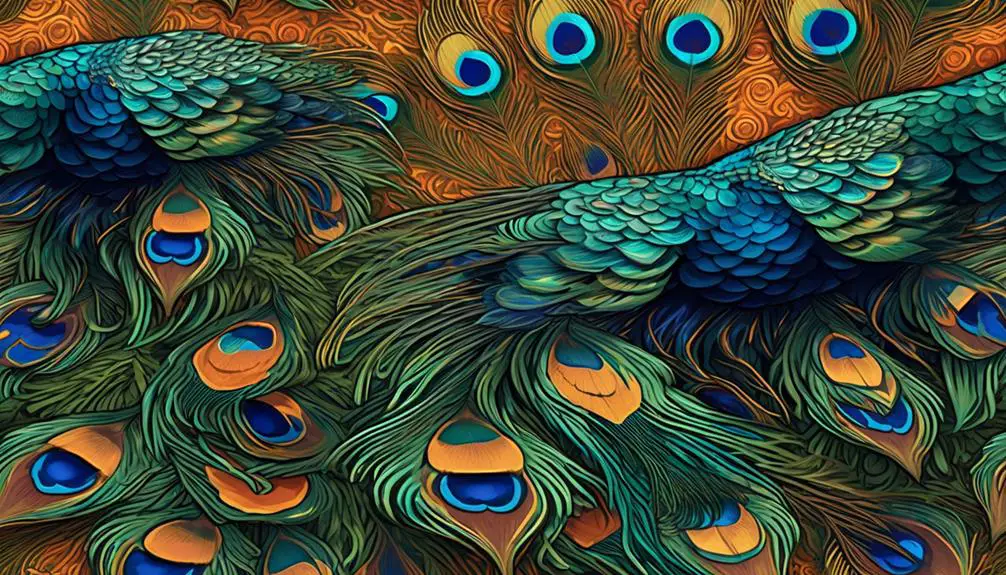
Feathers serve a variety of essential functions for birds, enabling them to achieve efficient flight, regulate body temperature, and camouflage against predators.
Firstly, feathers help birds stay light, allowing them to fly efficiently. The structure and arrangement of feathers provide lift and maneuverability during flight, aiding in stability and steering.
Feathers also play a crucial role in insulation and temperature regulation. They help birds resist temperature changes and provide a layer of insulation to keep their bodies warm.
Additionally, feathers can be used for camouflage against predators. Birds have evolved to have feathers that match their surroundings, making it easier for them to blend in and avoid detection. This camouflage helps protect them from predators and increases their chances of survival.
Feathers also have non-physical functions, such as visual communication. Birds use their feathers to attract mates, display dominance or submission, and communicate with others of their species.
Birds With Feathers
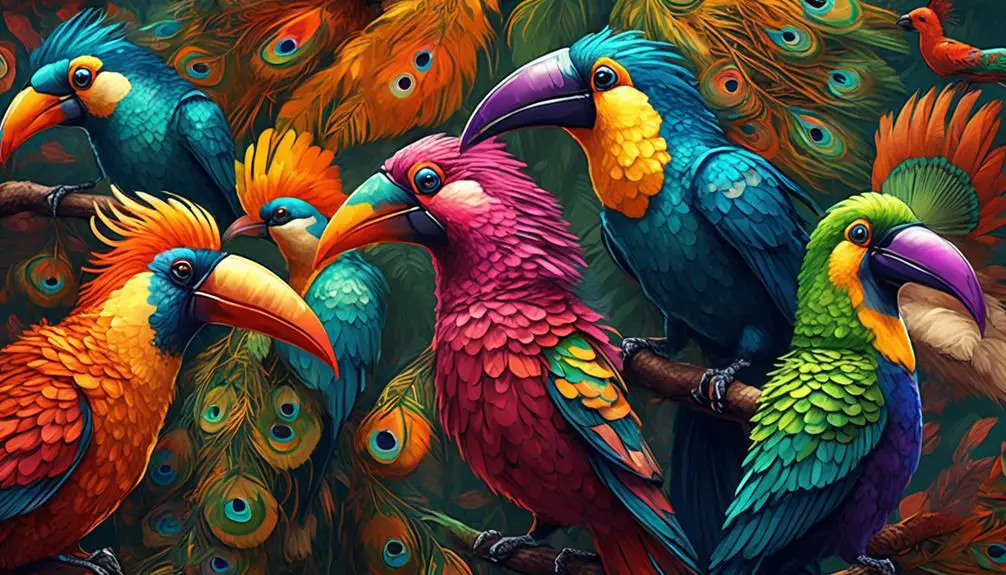
Birds, including pigeons, owls, eagles, chickens, penguins, emus, robins, hummingbirds, peacocks, cardinals, and turkeys, are all examples of animals with feathers. Feathers play a crucial role in the survival and behavior of these avian creatures.
Pigeons, for instance, possess various types of feathers, such as down feathers, hair feathers, fluff feathers, contour feathers, tail feathers, and wing feathers. Owls, on the other hand, have contour feathers, down feathers, semiplumes, bristles, and filoplumes. Eagles showcase rectrices, scapulars, and tertials. Chickens exhibit downy yellow feathers in hatchlings and regular feathers in mature individuals. Penguins possess small and stiff feathers, while emus display long brown feathers with shorter ones on their necks. Robins have distinctive and colorful feathers, and hummingbirds showcase primary feathers, secondary feathers, and tail feathers. Peacocks are renowned for their extravagant plumage, featuring tail feathers and wing feathers. Cardinals boast bright red feathers, with males exhibiting more vibrant hues than females.
Feathers serve multiple functions, including providing insulation, aiding in flight, offering camouflage, and facilitating communication. They grow from follicles in the skin and undergo molting to replace old feathers. Feathers are composed of keratin and possess a central quill, plumule, flue, and interlocking barbs and barbules. Birds meticulously preen and clean their feathers to maintain their condition.
The evolution of feathers is believed to have originated from reptilian scales, and they’ve since become one of nature’s most remarkable adaptations.
Feather Growth and Maintenance
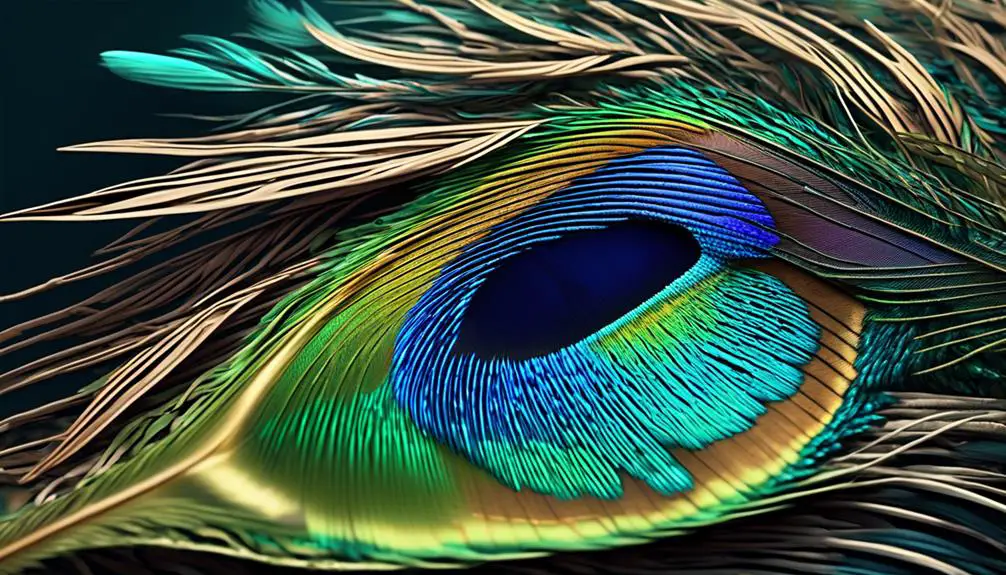
Now let’s explore the fascinating process of feather growth and maintenance in birds.
Feathers grow from follicles in the skin, and birds undergo molting to replace old feathers with new ones. The molting process can vary between species, but ultimately, new feathers grow in place of shed ones.
Birds also engage in preening and cleaning behaviors to ensure the proper condition and functionality of their feathers.
Feather Growth Process
Feather growth in birds is a complex process that occurs through the development and maintenance of feather follicles in the skin. It begins with the formation of a new feather germ, which consists of a small, bud-like structure that contains the genetic information needed for feather growth.
As the feather germ develops, it elongates and differentiates into various structures, including the central quill, barbs, and barbules. The cells in these structures produce keratin, a protein that gives feathers their strength and flexibility.
The growing feather is nourished by blood vessels in the follicle, which supply the necessary nutrients for growth. Once the feather is fully developed, it emerges from the follicle and is ready for use.
Birds maintain their feathers by preening, which involves cleaning, aligning, and oiling the feathers to keep them in optimal condition.
Molting and Replacement
After completing the process of feather growth, birds undergo molting and replacement to maintain the condition and functionality of their feathers.
Molting is the natural shedding of old feathers, which are replaced by new ones. The timing and duration of molting can vary between bird species. During molting, new feathers grow in place of the shed ones. This process ensures that birds have fresh and intact feathers for efficient flight, insulation, and other functions.
In addition to molting, birds also engage in preening and cleaning behaviors to maintain the condition of their feathers. Preening involves the bird using its beak to align and zip the barbs and barbules of the feathers, ensuring they’re interlocked and forming a smooth and functional surface.
Through these processes, birds ensure the continuous growth and maintenance of their feathers.
Preening and Feather Care
To ensure the continuous growth and maintenance of their feathers, birds engage in the essential behavior of preening and caring for their plumage.
Preening involves the meticulous grooming of feathers using the beak and feet. This behavior helps to realign and interlock the barbs and barbules of the feathers, ensuring a smooth and aerodynamic surface. Additionally, preening helps to remove dirt, parasites, and excess oil from the feathers.
Birds also engage in dust bathing, where they roll in fine dust or sand to help absorb excess oil and maintain feather cleanliness.
Feather care is crucial for maintaining the structural integrity and functionality of the feathers, allowing birds to effectively regulate their body temperature, achieve efficient flight, and display vibrant plumage.
Feather Evolution
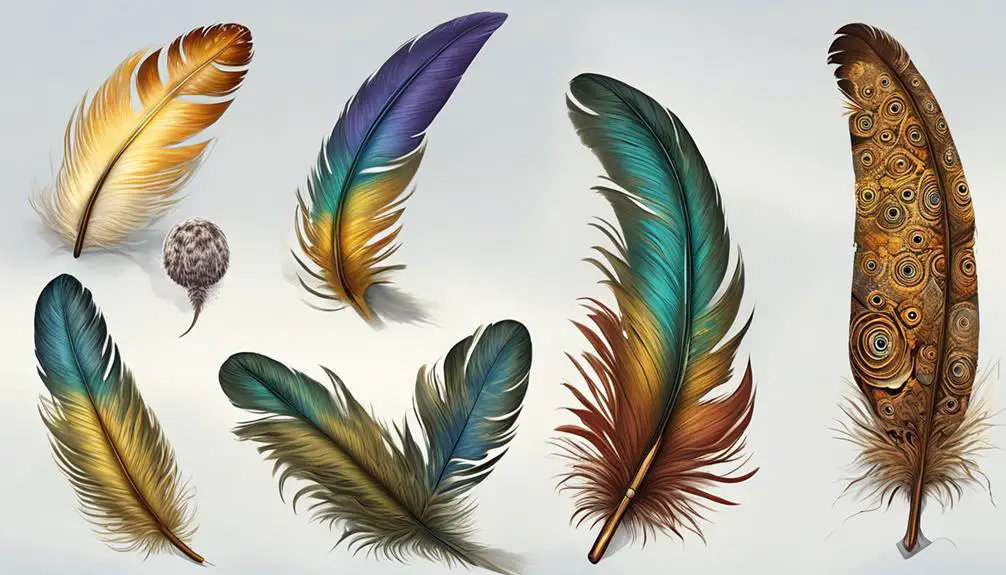
Feathers, one of nature’s most remarkable adaptations, are believed to have evolved from reptilian scales. The evolution of feathers is a fascinating process that can be traced back to early feathered dinosaurs found in the fossil record. Initially, feathers were used for insulation and display, providing warmth and attracting mates. Over time, feathers evolved further to serve the purpose of flight in birds, enabling them to soar through the skies with grace and precision.
The development of feathers involved a series of complex changes. The structure of feathers is composed of keratin, the same substance found in human hair and nails. Feathers have a central quill that provides support and attachment, while the plumule at the base of the feather aids in insulation. The flue of the feather provides strength and flexibility, allowing for efficient flight. The interlocking barbs and barbules form a flat surface, ensuring that the feathers remain intact and streamlined during flight.
Feather evolution is considered a significant milestone in the history of life on Earth. These intricate structures have provided birds with the ability to navigate their environments, escape predators, and engage in complex behaviors such as courtship displays. The evolution of feathers showcases the incredible adaptability and ingenuity of nature, highlighting the astonishing diversity of life on our planet.
Peacock Feathers
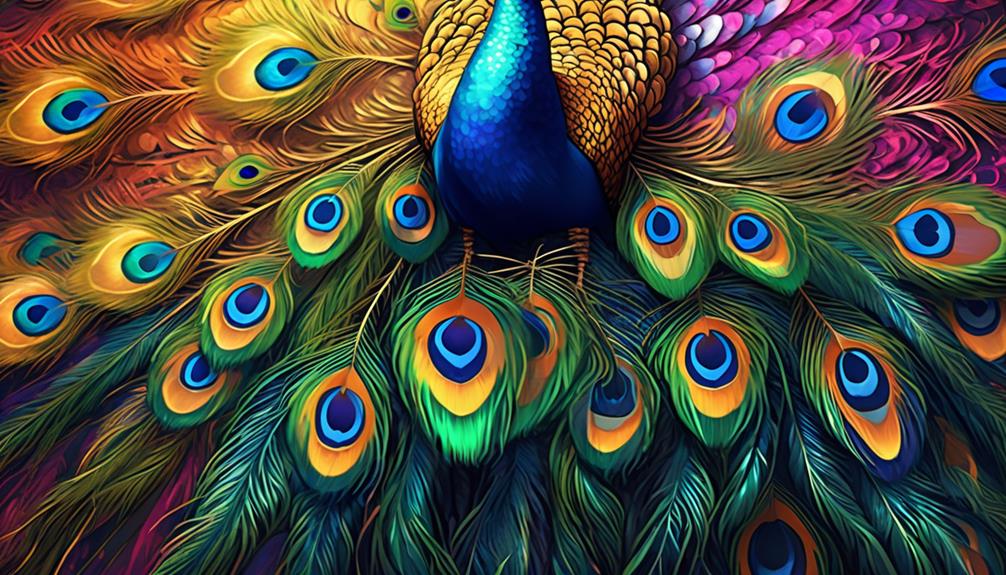
Peacock feathers, with their distinctive patterns and vibrant colors, are easily distinguished from the feathers of other birds. The most striking feature of peacock feathers is their long, elegant tail feathers. These feathers have a unique structure consisting of a central quill, plumule, flue, and ‘eye’ markings.
The quill provides support and attachment for the feather, while the plumule at the base helps with insulation. The flue gives the feather strength and flexibility. The most eye-catching aspect of peacock feathers is the presence of ‘eyes’ or markings on the feathers. These markings are created by the arrangement of barbs and barbules, which interlock to form a flat surface.
The vibrant colors of peacock feathers are a result of light interference caused by the microscopic structure of the feather. This phenomenon, known as iridescence, gives the feathers their shimmering appearance. It’s important to note that while male peacocks have these magnificent tail feathers, female peahens also have feathers, but they aren’t as iridescent or bright.
Peacock feathers are truly a remarkable example of nature’s beauty and intricacy.
Peacock Flight
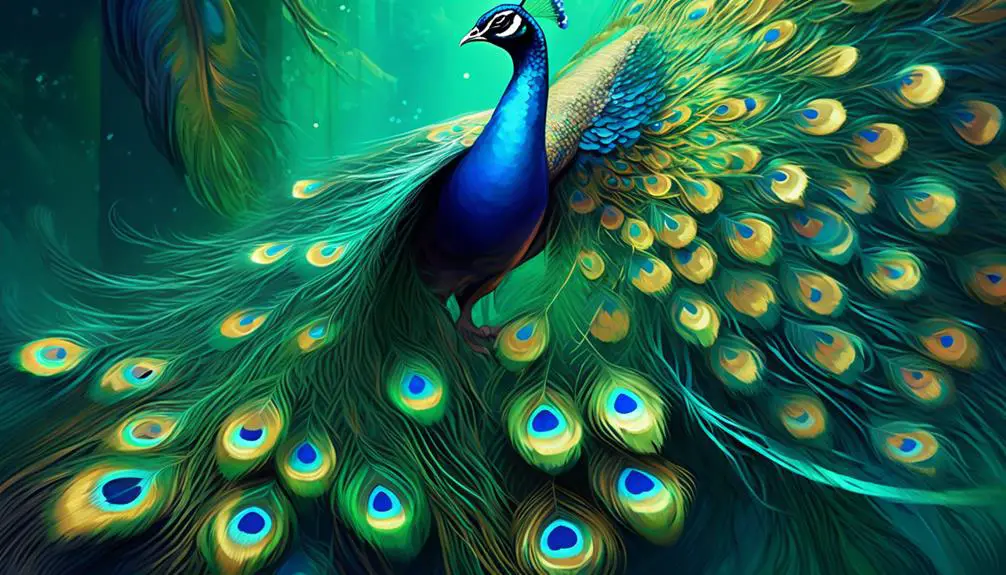
Peacock flight is an intriguing aspect of their behavior. While peacocks are known for their stunning feathers, their flight capabilities are limited due to their weight.
Although they can fly short distances when startled, they’re unable to sustain long flights like other birds.
Flight Capabilities of Peacocks
With their distinctive and vibrant feathers, peacocks possess flight capabilities that are unique among birds. However, due to their weight, peacocks aren’t well-suited for sustained long-distance flight like other bird species. Peacocks are the heaviest flying birds, which limits their ability to achieve prolonged flight. While they’re capable of taking flight when startled or to escape from predators, their flight is generally limited to short distances.
Peacocks rely more on their beautiful feathers for display and courtship rather than for extensive flight. The intricate patterns and colors of their feathers serve as a visual communication tool to attract mates and establish dominance. Thus, while peacocks do have flight capabilities, their primary function lies in their stunning plumage rather than their ability to soar through the skies.
Limitations of Peacock Flight
The flight capabilities of peacocks, despite their distinctive and vibrant feathers, are limited due to their weight.
Peacocks are the heaviest flying birds, which hinders their ability to fly long distances. While they can take flight when startled, their flights are typically short and low to the ground.
The weight of their elaborate tail feathers, which can reach up to six feet in length, poses a significant challenge for sustained flight. These feathers add excessive drag, making it difficult for peacocks to generate enough lift to stay airborne for extended periods.
Additionally, the size and weight of their bodies also contribute to their flight limitations.
Despite their captivating feathers, peacocks are primarily known for their stunning displays rather than their aerial prowess.
Cardinal Feathers
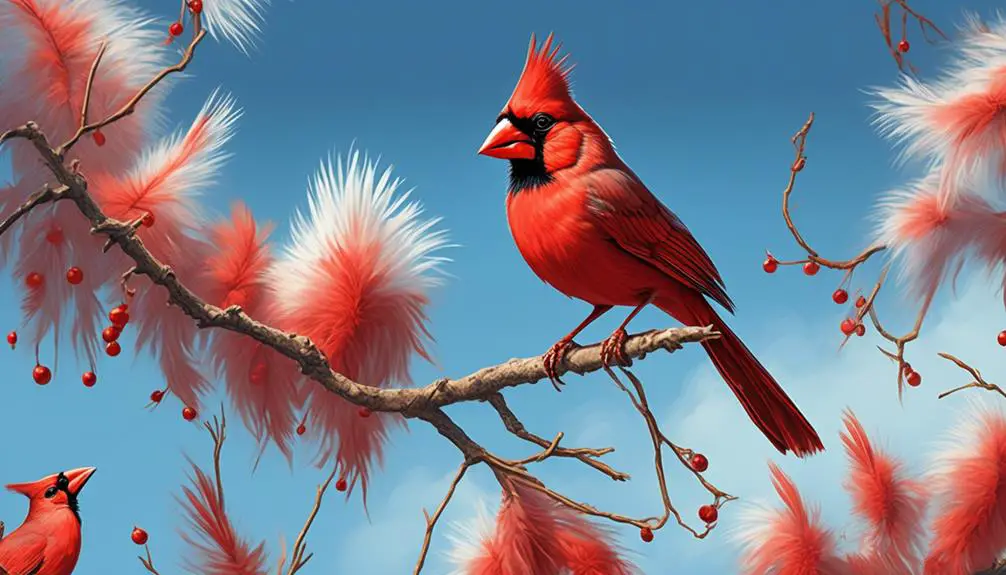
Cardinal feathers, with their distinctive red coloration, are essential for flight and play a crucial role in the aerodynamic capabilities of these birds. Cardinals, scientifically known as Cardinalis cardinalis, are small songbirds that are highly recognized for their vibrant plumage. Their feathers are arranged in a way that optimizes flight efficiency and increases their wingspan. Cardinals possess primary feathers, which are located at the tips of their wings and provide the necessary lift for sustained flight. Rectrices, or tail feathers, aid in stability and steering during flight. Secondary feathers, found closer to the body, contribute to the overall maneuverability of these birds.
Throughout their lives, cardinals undergo molting, a process where they shed their older feathers and grow new ones. Interestingly, the newly grown feathers start off without the characteristic red coloration but gradually mature into the bright red feathers that cardinals are well-known for. The structure of cardinal feathers is composed of keratin, the same protein found in human hair and nails. Each feather possesses a central quill that provides support and attachment, a plumule at the base for insulation, a flue for strength and flexibility, and interlocking barbs and barbules that create a flat surface.
Feather Structure
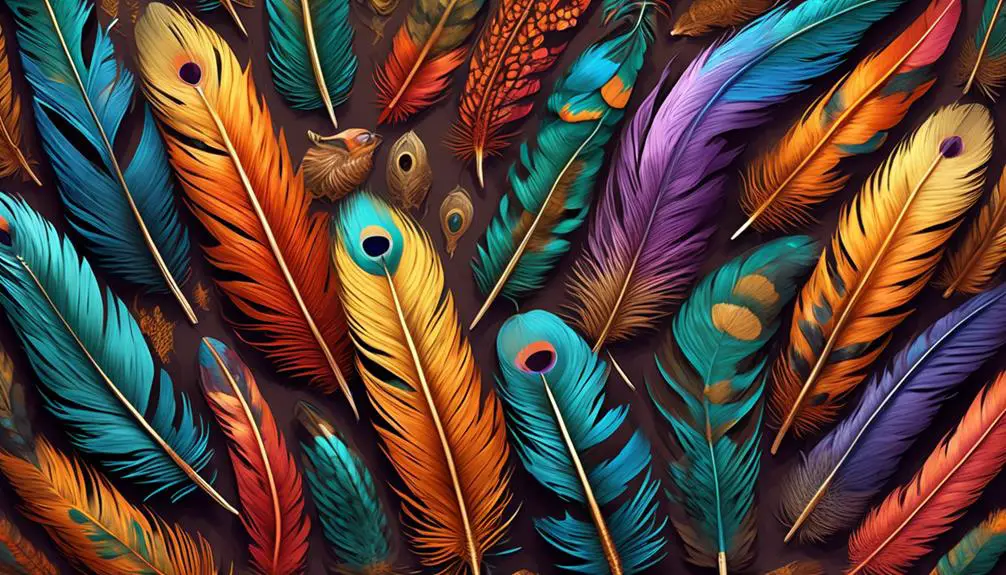
Now let’s examine the intricate structure of feathers.
Feathers are composed of keratin, a protein found in human hair and nails. They’ve a central quill that provides support and attachment, while the plumule at the base of the feather helps with insulation.
The flue provides strength and flexibility, and the interlocking barbs and barbules form a flat surface, allowing feathers to serve their various functions.
Feather Composition and Function
Feathers, composed of keratin and characterized by a central quill, plumule, flue, and interlocking barbs and barbules, serve multiple functions in birds. They provide support and attachment, insulation, strength, flexibility, and a flat surface for efficient flight.
The central quill acts as the backbone of the feather, providing support and attachment to the bird’s body.
The plumule, located at the base of the feather, helps with insulation by trapping air and regulating body temperature.
The flue, a central hollow shaft, provides strength and flexibility, allowing the feather to withstand the forces of flight.
The barbs and barbules interlock to form a flat surface, creating the aerodynamic shape necessary for efficient flight.
Each component of the feather structure is essential for its function in aiding birds in their various activities and survival.
Feather Growth and Maintenance
After understanding the composition and function of feathers, it’s important to delve into the process of feather growth and maintenance, specifically focusing on the intricate structure that enables feathers to fulfill their crucial roles in birds’ lives.
Feathers grow from follicles in the skin, and birds molt to replace old feathers. The molting process can vary between species, but new feathers grow in place of shed ones.
To maintain the condition of their feathers, birds engage in preening and cleaning behaviors.
Feathers are composed of keratin, the same material as human hair and nails. They have a central quill for support and attachment, a plumule at the base for insulation, a flue for strength and flexibility, and interlocking barbs and barbules that form a flat surface.
Pigeons
Pigeons, with their various types of feathers, play a significant role in the avian world. These birds possess a range of feather types, each serving a specific function.
Pigeons have down feathers, which provide insulation and help regulate body temperature. Hair feathers, found on their heads, offer protection and aid in sensory perception. Fluff feathers are soft and downy, contributing to the overall insulation of the bird. Contour feathers, located on the body, wings, and tail, provide lift and maneuverability during flight. Tail feathers, as the name suggests, are primarily responsible for stability and steering. Wing feathers are crucial for flight, generating lift and allowing the bird to soar through the air.
Pigeons’ feathers are composed of keratin, the same material as human hair and nails, with a central quill for support and attachment, plumules for insulation, flues for strength and flexibility, and interlocking barbs and barbules that create a flat surface.
Understanding the diverse types and functions of pigeon feathers contributes to our knowledge of bird anatomy and the remarkable adaptations that enable avian flight.
Owls
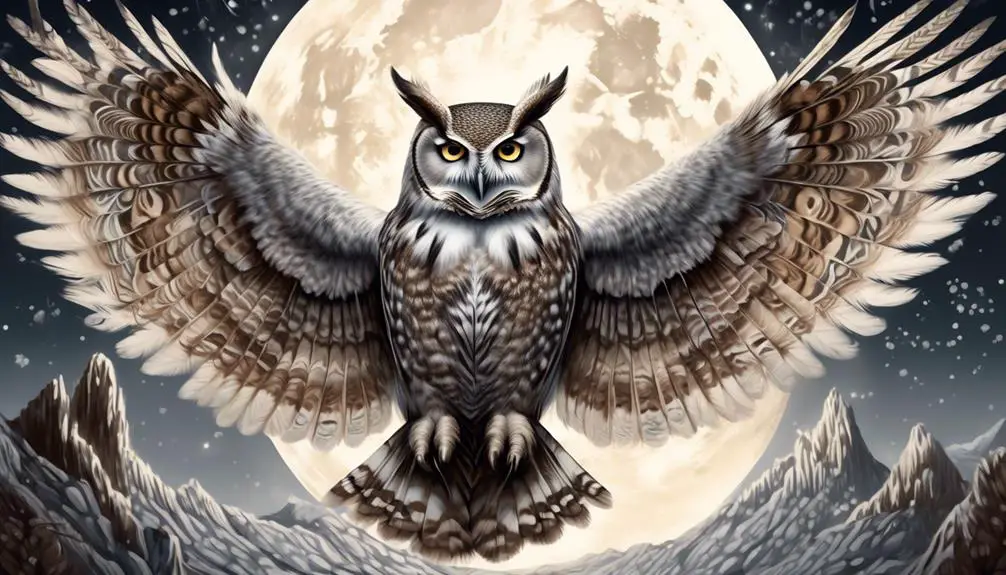
Owls, with their unique adaptations and specialized feathers, are fascinating creatures in the avian world. These nocturnal birds of prey have several distinct feather types that contribute to their remarkable hunting abilities.
One of the most notable feathers found on owls is the contour feather. These feathers give owls their characteristic appearance and help streamline their bodies for silent flight.
The down feathers of owls provide insulation, keeping them warm during cold nights. Semiplumes, another type of feather, assist in maintaining the bird’s body temperature by providing additional insulation.
Owls also possess bristles around their beaks and eyes, which serve as sensory organs, helping them detect prey in the dark. Filoplumes, the smallest and least visible feathers on owls, play a crucial role in providing feedback on the position of other feathers. This allows owls to make precise adjustments for optimal flight performance.
The specialized feathers of owls are a testament to their remarkable adaptations and make them truly captivating creatures in the avian world.
Eagles
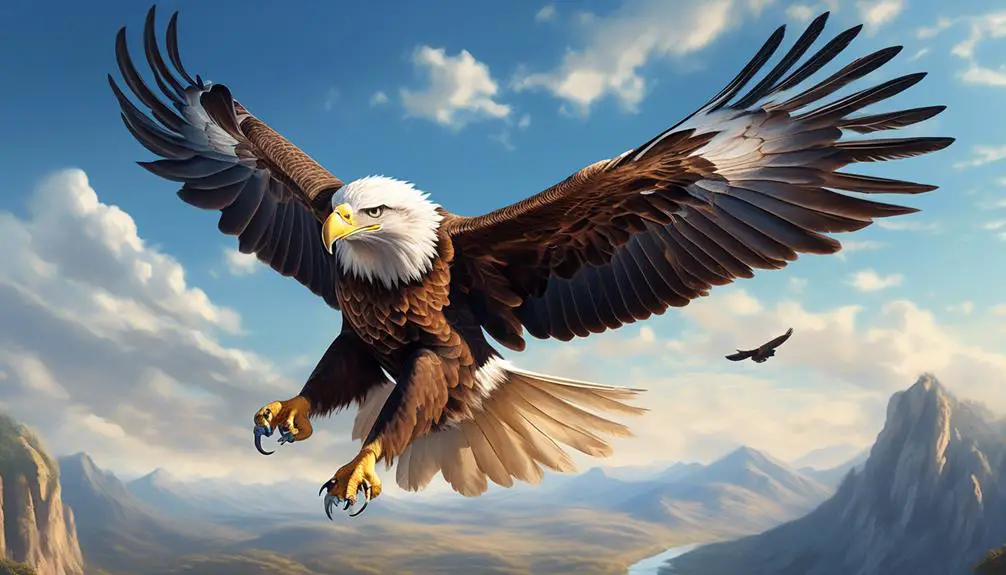
Eagles are majestic birds of prey known for their impressive hunting skills and distinctive feather types. These birds have three main types of feathers: rectrices, scapulars, and tertials.
Rectrices are the large, strong feathers that make up the tail. They provide stability and control during flight, allowing eagles to maneuver with precision.
Scapulars are the feathers that cover the shoulders and upper back of the eagle. They play a crucial role in the bird’s aerodynamics by reducing drag and providing lift.
Tertials are the feathers found at the leading edge of the eagle’s wings. They help to create a smooth surface and improve the bird’s ability to generate lift.
The feathers of eagles are typically brown, rust, or black, with white feathers on their necks for bald-headed eagles. These colors provide camouflage in their natural habitats, allowing them to blend in with their surroundings as they soar through the sky in search of prey.
Chickens
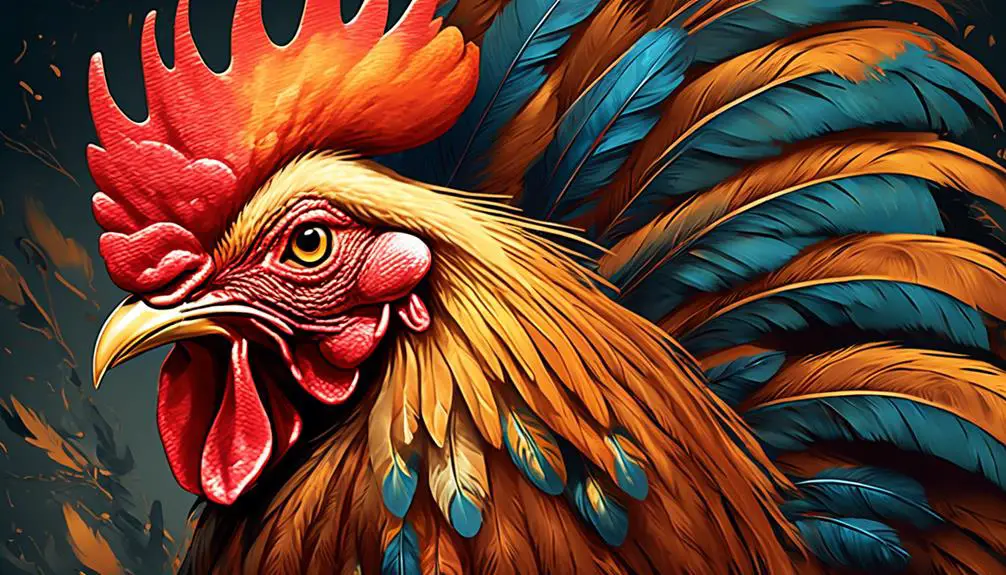
As we move on to discussing chickens, we shift our focus from the majestic eagles to these domesticated birds known for their varied feather types. Chickens exhibit a range of feather colors and patterns, making them an interesting subject for study.
In hatchlings, chickens have downy yellow feathers that provide warmth and protection. As they mature, chickens develop regular feathers that serve various functions. These feathers are composed of keratin, the same material found in human hair and nails. They have a central quill for support and attachment, a plumule at the base for insulation, and a flue that provides strength and flexibility.
Chickens also have interlocking barbs and barbules that form a flat surface, allowing for efficient flight and maneuverability. The feathers on chickens can come in different colors and patterns, including black, white, brown, and speckled. Some chickens even have distinctive feather patterns, such as the ‘lace’ pattern found in certain breeds.
Feathers play a crucial role in the chicken’s life, providing insulation, protection, and aiding in flight. They also contribute to the visual communication between chickens, attracting mates, and displaying dominance or submission. Through the study of chickens’ feathers, we can further understand the fascinating adaptations and diversity found in these domesticated birds.

Erzsebet Frey (Eli Frey) is an ecologist and online entrepreneur with a Master of Science in Ecology from the University of Belgrade. Originally from Serbia, she has lived in Sri Lanka since 2017. Eli has worked internationally in countries like Oman, Brazil, Germany, and Sri Lanka. In 2018, she expanded into SEO and blogging, completing courses from UC Davis and Edinburgh. Eli has founded multiple websites focused on biology, ecology, environmental science, sustainable and simple living, and outdoor activities. She enjoys creating nature and simple living videos on YouTube and participates in speleology, diving, and hiking.
🌿 Explore the Wild Side!
Discover eBooks, guides, templates and stylish wildlife-themed T-shirts, notebooks, scrunchies, bandanas, and tote bags. Perfect for nature lovers and wildlife enthusiasts!
Visit My Shop →
